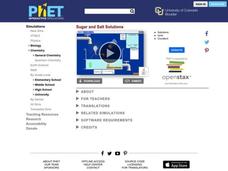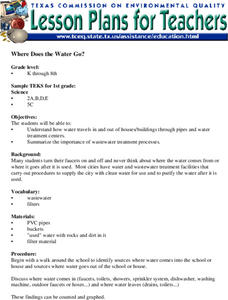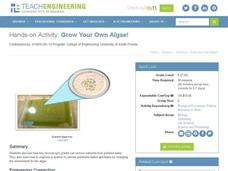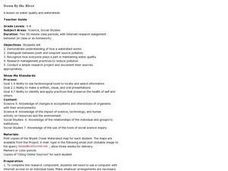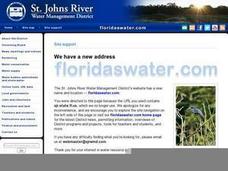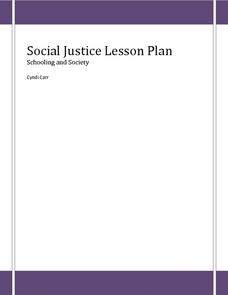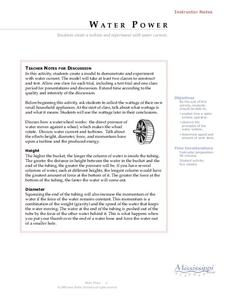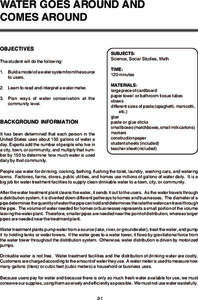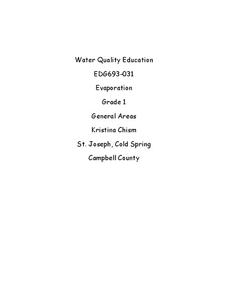PhET
Sugar and Salt Solutions
Ionic bonds form from electrostatic energy, allowing for higher conductivity than those seen in covalent bonds. In the simulation, learners add sugar and salt to water and see the effects on concentration and conductivity of their...
Curated OER
Where Does the Water Go?
Students examine how water travels in and out of houses through pipes. They discover how water is treated and discuss the importance of the treatment centers. They participate in an experiment with different size piping and water.
Curated OER
Water Is Cool!
Students study water as a non-renewable resource. In this water lesson plan, students examine sources of water, uses of water, and explain why it is important to take care of water sources for the common good. They research the water...
Curated OER
Save That Water
Students investigate water conservation. In this environmental instructional activity, students brainstorm ways they use water and discuss ways to conserve water. Students illustrate and write about their method of water conservation.
Kenan Fellows
Use of Dichotomous Keys to Identify Stream Organisms
What kind of organisms are living in the stream? After an explanation on how to use a dichotomous key, groups of three to four use the keys to identify macroinvertebrates from a local freshwater stream. Using the the concept of...
Teach Engineering
Grow Your Own Algae!
Develop a model of a wastewater treatment center. The last activity of the unit has pupils mix a lake water sample into a tank of water containing fertilizers. Over time, the algae from the lake water grows and removes the nutrient-rich...
Curated OER
Lithosphere and Groundwater
Focusing on the quality of our water sources, these slides are full of information about the aspects of our soil and groundwater that may affect pollution. The leaching of pollutants and their impact on health is explained. ...
Curated OER
What's in the Water?
Fifth graders use the dots to simulate water pollutants in a lake. They use cups to collect a sample of "water." Students sort the dots by color and record the number of each dot color under the correct pollutant name in the Lake Water...
Curated OER
Dirt: Making Dirty Water Clean!
Fourth graders study soil and water. For this water lesson students work in groups and use a filter to clean water.
Curated OER
Creek Monitoring
Sixth graders conduct a variety of assessments at a local stream to determine if it is a suitable habitat for salmon. They measure temperature, tubidity, dissolved oxygen, pH levels, bacteria and nutrients. In this unit, 6th graders work...
Curated OER
Down By the River
Students examine how watersheds work and determine the difference between point and nonpoint source pollution. They research management practices to reduce pollution and investigate how everyone can participate in reducing water pollution.
Curated OER
The Water Cycle and Global Warming
Students study the flow of water in the environment. In this water cycle lesson students evaluate the consequences of changes in the water cycle using data.
Curated OER
Lesson 11 - Potable Water
Students investigate the meaning of potable water and water reuse. They define water quality and quantity problems. They complete worksheets, a quiz and design a poster.
Curated OER
Muddy Waters
Students read the book the Dirt Boy. In this design and problem solving lesson, students create a way to clean muddy water. Students give their ideas and discuss them. The teacher shows a filter and demonstrates what it does to the...
Curated OER
The Water Dilemma
Students read about and discuss the importance of easily available, clean drinking water. They participate in a role play scenario in which only one drinking fountain in the school has potable water.
Curated OER
The Water in Our Lives: Kit Practice
Students examine a local water source using testing kits to determine water qualitiy. They identify the pollutants and contaminants in each sample. They determine if samples fall within an acceptable range for drinking water.
Curated OER
Social Justice-Water in Developing Countries
Students explore how water shortage affects everyday life. In this social justice activity, students discuss information about water shortage in Ghana. A water shortage simulation/game is played in which a "Canadian" team starts with a...
Curated OER
Water Power
Students explore how a water turbine operates and observe the principles of the water turbine. They account for the speed of the water turbine by various experiments and records of test results. In groups the students create a working...
Curated OER
Testing the Waters
Eleventh graders examine a local body of water. In this science lesson, 11th graders collect water samples to test. Students analyze the data and make conclusions. Students create tables and graphs of the data.
Curated OER
WATER GOES AROUND AND COMES AROUND
High schoolers build a model of a water system from the source to users and read and interpret a water meter.
Curated OER
Water Conservation/ Pollution: Why is the Water Running?
Students consider water conservation and chemical pollution of water. In this water use instructional activity, students discover how water towers and dams are used to take water to desired locations. Students also discuss the effects of...
Curated OER
How Our Water Becomes Polluted
Students list causes of water pollution, discuss how people contribute to water pollution, and explain concept of watershed.
Curated OER
Salinity in Mill Creek
Fifth graders use water samples collected at three different locations of Utah's Mill Creek to test salinity of water, hypothesize about salinity levels at each location, record results, and discuss their findings with classmates. ...
Curated OER
Evaporation
First graders explore, analyze, document and study weather and the water cycle. They observe the weather and begin a weather journal. Each student interacts with the concepts of evaporation, condensation and precipitation, clouds,...
